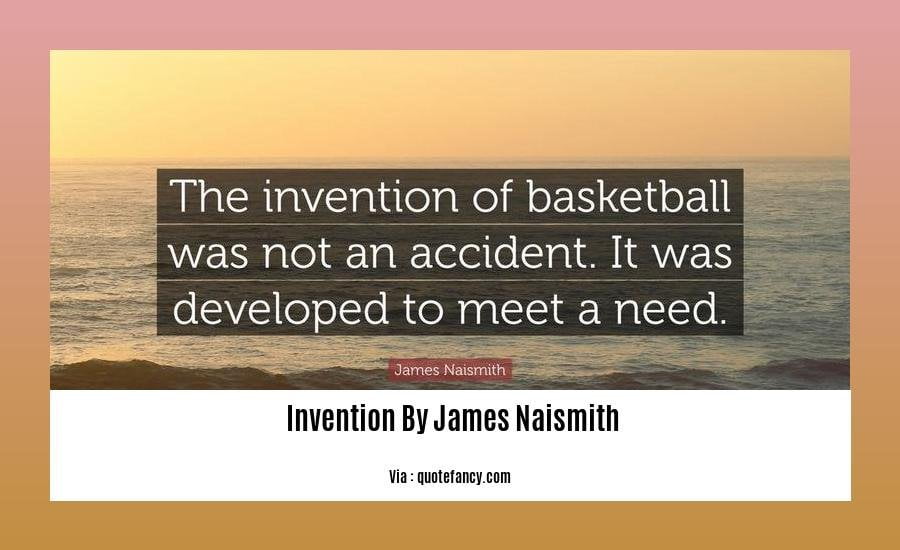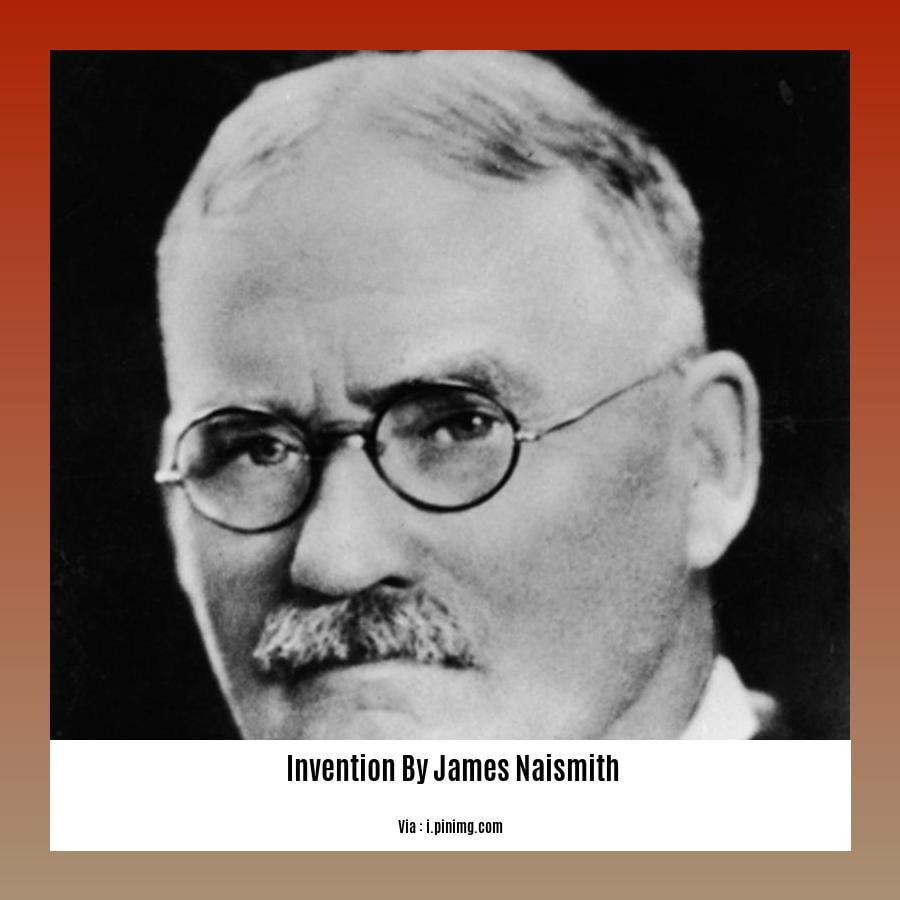Unveiling the genesis of the beloved sport of basketball, we embark on a journey into the mind of its inventor, James Naismith. [- A Sporting Revolution: The Invention of Basketball by James Naismith] chronicles the remarkable tale of how a simple game, born from necessity, transformed into a global phenomenon, leaving an indomitable mark on the world of sports and beyond.
Key Takeaways:
- Basketball was invented in 1891 by James Naismith at Springfield College.
- Naismith was a physical educator, doctor, chaplain, and coach.
- He was born in Canada and played football at McGill University.
- Naismith created the 13 original basketball rules.
- He coached the first basketball team at the University of Kansas.
The Invention of Basketball by James Naismith

James Naismith, a Canadian physical educator, invented basketball in 1891. Naismith was born in Almonte, Ontario, in 1861 and was a multi-talented athlete who played football at McGill University.
Seeking an indoor activity for his students at Springfield College in Massachusetts, Naismith devised a game using a soccer ball and peach baskets. The first game was played on December 21, 1891, with nine players on each team. The objective of the game was to throw the ball into the opposing team’s peach basket.
Naismith’s invention quickly gained popularity, and within a few years, basketball was being played in schools and YMCAs across the country. The game was codified with the development of the official rules in 1894, and the National Basketball Association (NBA) was founded in 1946.
Today, basketball is one of the most popular sports in the world, played by millions of people in over 200 countries. It is an Olympic sport and is a major part of popular culture, with millions of fans worldwide.
Naismith’s Legacy
Naismith’s invention of basketball has had a profound impact on global culture. The game has provided a healthy and enjoyable outlet for millions of people, and it has also been a force for social change. Basketball has broken down racial barriers and promoted equality, and it has given hope to disadvantaged youth around the world.
Naismith’s legacy is one of innovation and service. He was a pioneer in the field of physical education, and his invention of basketball has had a lasting impact on the world. He was truly a visionary leader, and his work continues to inspire people today.
Timeline of Key Events in the Invention of Basketball
- 1861: James Naismith is born in Almonte, Ontario, Canada.
- 1883: Naismith attends McGill University in Montreal, where he is an outstanding football player.
- 1890: Naismith moves to the United States to attend Springfield College in Massachusetts.
- 1891: Naismith invents basketball as an indoor activity for his students at Springfield College.
- 1894: The official rules of basketball are codified.
- 1946: The National Basketball Association (NBA) is founded.
- 2023: Basketball is one of the most popular sports in the world, played by millions of people in over 200 countries.
Discover the fascinating evolution of the game we love in our comprehensive exploration of the history of basketball.
Learn about the formation of the legendary National Basketball Association (NBA) by exploring our detailed account of its NBA formation.
Embrace the global reach of basketball and immerse yourself in the captivating stories of its global spread.
The evolution of basketball after its inception

Basketball’s humble beginnings in a Springfield, Massachusetts YMCA in 1891 have given way to a global phenomenon enjoyed by millions worldwide. The game’s evolution since James Naismith’s initial invention has been a testament to its adaptability and enduring appeal.
The spread of basketball
In the early 20th century, basketball rapidly gained popularity across the United States, with high schools and colleges embracing the fast-paced, high-scoring game. By the post-World War II era, basketball had become a global phenomenon, with teams and leagues springing up in countries around the world.
Rule changes and innovations
The game’s rules have also seen significant evolution over the years. In 1894, the number of players on a team was standardized at five, and in 1936, the backboard was introduced to prevent players from interfering with the basket. The introduction of the three-point shot in 1979 revolutionized the game, opening up the court and encouraging more long-range shooting.
The rise of professional basketball
Professional basketball began in the early 20th century with the formation of the National Basketball Association (NBA) in 1946. The NBA has grown into one of the most popular sports leagues in the world, featuring some of the greatest players in history, including Michael Jordan, LeBron James, and Stephen Curry.
Key Takeaways:
- Basketball’s popularity spread rapidly across the United States and internationally after its invention.
- Rule changes and innovations have shaped the game’s evolution, including the introduction of the five-player team, backboard, and three-point shot.
- Professional basketball has become a global phenomenon, with the NBA showcasing some of the world’s greatest players.
Sources:
- History of Basketball | Britannica
- Here’s the history of basketball—from peach baskets in Springfield to buzzer beaters on TV | National Geographic Society
The Spread of Basketball and Its Lasting Legacy
In 1891, Dr. James Naismith, a Canadian physical education instructor, invented basketball as a less injury-prone sport than football. Little did he know that his invention would become a global phenomenon, captivating millions worldwide.
The Spread of Basketball
Basketball’s popularity soared in the early 20th century, spreading rapidly through the YMCA network and beyond. By the 1930s, the game had become a staple in high schools and colleges across the United States. The formation of the National Basketball Association (NBA) in 1946 further propelled the sport’s popularity, showcasing the game’s fast-paced action and athleticism.
After World War II, basketball’s popularity surged internationally. The 1950s and 1960s saw the rise of legendary players like Wilt Chamberlain and Bill Russell, whose dominance on the court captivated global audiences. Today, basketball is played in over 200 countries, with leagues and tournaments spanning every continent.
Its Lasting Legacy
Basketball’s impact extends far beyond the court. It has become a cultural icon, inspiring movies, TV shows, and video games. The sport has also played a significant role in promoting diversity and inclusion, breaking down barriers and fostering a sense of community.
Key Takeaways:
- Basketball was invented by James Naismith in 1891 at Springfield College in Massachusetts.
- The game quickly gained popularity and spread around the world through the YMCA network.
- The NBA’s formation in 1946 popularized basketball internationally.
- Today, basketball is played in over 200 countries and is a global cultural phenomenon.
Sources:
– James Naismith | Biography, Rules of Basketball, & Facts
– Dr. James Naismith – The Man Who Invented Basketball
Influence and Cultural Appropriation on Basketball as a Sport
Basketball, the beloved sport that has captivated generations, is more than just a game; it’s a cultural phenomenon that transcends boundaries and fosters a sense of community. The invention of basketball in 1891 by James Naismith marked a sporting revolution, but its impact extends far beyond the court.
Cultural Impact
Basketball has played a significant role in shaping global culture, inspiring countless individuals and leaving an enduring legacy. The game has become a symbol of teamwork, fair play, and determination, fostering a sense of unity among people from diverse backgrounds. The iconic figures of the sport, such as Michael Jordan, Magic Johnson, and LeBron James, have not only been exceptional athletes but also role models and sources of inspiration for aspiring players.
Influence on Youth Culture
Basketball has had a profound influence on youth culture, particularly in urban areas. The game provides a platform for expression, skill development, and social interaction. Basketball courts have become gathering places for young people, fostering friendships and a sense of belonging. The game has also been credited with reducing juvenile delinquency and promoting healthy lifestyles in at-risk communities.
Appropriation and Identity
While basketball has brought people together, it has also faced criticism for cultural appropriation. Some critics argue that the game has been adopted by non-African American communities without fully acknowledging its roots and the cultural significance it holds for this marginalized group. The appropriation of basketball has raised important questions about identity, representation, and the power dynamics within society.
The Future of Basketball
As basketball continues to evolve, it is crucial to recognize and address the influence and cultural appropriation on the sport. By embracing diversity, promoting inclusivity, and acknowledging the game’s origins, we can ensure that basketball remains a force for positive change and a testament to its enduring legacy.
Key Takeaways:
- Basketball has a profound cultural impact, fostering community and inspiring individuals across the globe.
- The game has played a significant role in youth culture, providing a platform for expression and social interaction.
- Basketball has faced criticism for cultural appropriation, raising questions about identity, representation, and power dynamics.
- By embracing diversity, promoting inclusivity, and acknowledging the game’s origins, we can ensure the future of basketball as a force for positive change.
Relevant URL Sources:
Exploring the Global Impact of Basketball: Its Influence on Culture and Society
Here’s the History of Basketball—From Peach Baskets in Springfield to…
















